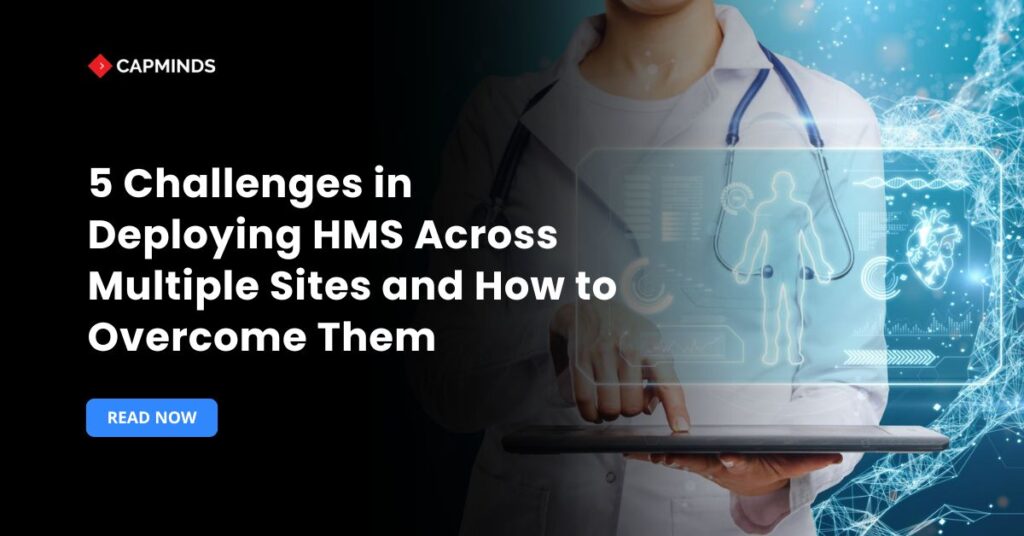5 Challenges in Deploying HMS Across Multiple Sites and How to Overcome Them
Hospitals and health systems rely on integrated HMS/EHR platforms and patient management tools to coordinate care across locations. Deploying a unified system across multiple sites can break down data silos and streamline workflows, but it also introduces unique hurdles. As one industry guide notes, “growing a healthcare network across multiple sites demands robust, flexible IT systems,”.
To ensure success, hospitals must anticipate and address key challenges spanning data integration, workflows, infrastructure, staffing, and security. Below, we explore five major challenges of multi-site HMS rollouts and practical strategies to overcome them.
1. Data Integration and Interoperability
Deploying HMS/EHR software across locations means patient data must flow seamlessly between clinics, hospitals, labs, and other systems.
The biggest challenge is inconsistent data formats and legacy systems. Different sites often have varied EHR versions or ancillary systems, leading to “fragmented” patient records. To overcome this:
Adopt healthcare data standards
Use HL7 v2. x, FHIR, and DICOM messaging to exchange data. Industry experts recommend implementing HL7/FHIR interfaces so that all systems “speak” a common language. This lets labs, radiology, pharmacy, and other modules write back to a central record.
Use a central integration engine or API layer
Rather than point-to-point links, centralize interface logic in an integration platform or enterprise service bus.
- This simplifies adding new sites: you only configure each site’s connection to the central engine, avoiding a “spaghetti” of connections.
- Expose open APIs on the EHR so modules (scheduling, billing, etc.) can integrate easily.
Implement a Master Patient Index (MPI)
Ensure each patient has a single identifier across all sites.
- As one guide warns, without a robust MPI, “John Smith” at one clinic might not be recognized as the same person elsewhere.
- A unified MPI or patient-matching service prevents duplicate records and ensures the patient’s full history is available network-wide.
Conduct extensive testing
Before go-live, simulate live data flows between all sites. Use test “sandboxes” to validate every HL7/FHIR message path. An integration engine lets you run end-to-end tests once, instead of separately per site. Rigorous testing and validation at each phase avoids surprises when the system goes live.
By standardizing data formats and centralizing interfaces, hospitals can achieve true interoperability across sites. Some leading health networks, for example, use FHIR-based synchronization so that clinicians at any location see up-to-date patient labs and notes.
2. Standardized Workflows and Upgrades
Each facility often has its legacy workflows and preferences. Heavy customization can slow down a multi-site rollout. The challenge is to balance local needs with system-wide consistency. For example, ordering or scheduling forms might differ by clinic. To overcome this:
Minimize site-specific customization
Aim for standardized workflows wherever possible.
- Too much custom code at each location “hinders upgrades and multiplies support costs”.
- If different sites need special fields or forms, use the HMS’s built-in configuration tools (form builders, templates) rather than deep customizations.
Provide “super-users” and training at each site
Identify clinical champions and IT liaisons locally. These super-users help tailor workflows for their site while maintaining overall consistency.
Before go-live, involve staff early: explain benefits and address concerns. Studies show that transparent communication and hands-on training reduce resistance. Provide user manuals and refresher sessions so all sites know the standard processes.
Plan phased upgrades and version control
Rolling out EHR updates across multiple hospitals is complex. Develop a release plan where updates are first tested at a pilot site, ensure interfaces are backward-compatible, then schedule rolling updates for all locations.
Keep all sites on the same code version to avoid incompatibilities. Regularly upgrading in lockstep ensures that all facilities benefit from new features and fixes without creating fragmentation.
By enforcing standard workflows and a unified upgrade schedule, a health system avoids fragmentation. For instance, one guide recommends treating the multi-site rollout “like a product launch,” with checklists, playbooks, and project plans that make each new site’s deployment a repeatable process.
3. Infrastructure Resiliency and Scalability
Large-scale HMS deployments must serve many users and clinics without downtime.
Network and system availability is critical: an EHR outage can “cripple clinical care” across all sites. Key challenges include ensuring bandwidth, redundancy, and disaster recovery. To overcome them:
- Use geographic redundancy. Deploy the HMS in multiple data centers or cloud regions so that one site outage doesn’t take down the system. For example, mirror databases and cluster application servers across locations. Many health systems use active-active architectures (all sites live at once) so traffic can shift automatically. Always test failover: for instance, simulate a data-center loss to verify services remain up.
- Replicate data continuously. Keep critical data in sync between sites. For example, backup EHR databases to the cloud or a secondary data center in near–real-time. Ensure network links have enough capacity to handle this replication traffic. This way, if one site fails, another has a near-current copy of all records.
- Test disaster recovery (DR) regularly. A plan is useless unless practiced. Conduct failover drills and recovery simulations to verify recovery time objectives. Detailed runbooks and checklists are essential for IT and clinical teams. Regular testing will uncover gaps so you can fix them before a real outage.
- Scale hardware and network for the load. Estimate peak usage (busy clinic hours, night shifts in other time zones) and load-test the system accordingly. Use load-balancing on web and database servers. If some sites have limited bandwidth, consider local caching or edge solutions. The goal is a smooth experience for end users at every site.
By building in redundancy and replication, hospitals ensure that one site’s failure doesn’t cascade across the network. For example, many providers now back up their primary EHR to cloud storage continuously and design networks so that a regional outage triggers an immediate failover.
4. Staffing, Training, and Change Management
A multi-site HMS rollout puts extra strain on IT and clinical staff. With limited IT personnel and variable tech skills across sites, even a great platform can stumble on adoption. Common issues include talent shortages and user resistance. To overcome these human factors:
Assign super-users
At each facility, designate power users who understand both the clinical workflows and the new system. Empower them to train colleagues and provide feedback.
Involving staff early – explaining why the new system benefits patients and clinicians – reduces resistance. Health systems recommend open forums and Q&A sessions so that staff can express concerns and see the value of change.
Provide comprehensive, ongoing training
Do not underestimate training needs.
- Offer hands-on training sessions, user guides, and refresher courses across all sites.
- Tailor training to each department’s workflows.
- Consider a mix of instructor-led courses, e-learning modules, and “office hours” support for questions.
- As one HMS guide notes, ongoing education (beyond just an initial go-live session) is key to bridging skill gaps and maintaining confidence.
Supplement IT resources
Multi-site IT demands often outpace in-house staff capacity. Consider outsourcing non-core tasks to managed service providers or bringing in consultants for specialized work (like network design or EHR upgrades). This frees internal staff to focus on priority projects.
Encourage mentorship between veteran IT staff and new hires. Budget for training IT personnel on new technologies so that skill levels keep pace with system complexity.
Addressing staffing and training upfront prevents burnout and rollout delays. For example, one implementation playbook suggests having a detailed “playbook” (checklists and project plan) so each new site is added in a repeatable way, reducing last-minute fire drills.
Involving users and IT partners early on ensures smoother transitions and higher adoption rates.
5. Security, Privacy, and Compliance
Finally, protecting patient data across distributed sites is non-negotiable. Every location must enforce uniform security policies and comply with regulations.
Key challenges include securing data in transit, preventing breaches, and managing user access. To overcome these:
Encrypt PHI in transit and at rest
All patient information flowing between sites or stored on servers should be encrypted. For example,
- Use HTTPS/TLS for web access
- VPNs or SSL for site-to-site links, and
- Disk/database encryption in data centers.
Industry best practices call for AES-128 or stronger for healthcare data. Treat encryption as a necessary control; conduct risk assessments to ensure compliance.
Enforce strict access controls
Implement multi-factor authentication and least-privilege access for all users. Adopt a “zero trust” mindset: never assume internal networks are safe.
Segment the network so that clinical systems are separated from guest Wi-Fi or administrative networks. This limits an attacker’s ability to move between systems. Regularly review user privileges and deactivate accounts for staff who leave or change roles.
Establish data governance and compliance agreements
Create a data governance board with clinical and IT leadership to oversee data policies. Define who “owns” each data element and who can authorize changes.
Ensure that business associate agreements (BAAs) or data-sharing agreements cover all sites. In practice, every participating facility must agree to the same privacy/security standards and processes.
Train staff on security best practices
The human element is often the weakest link. Conduct regular cybersecurity training and phishing simulations at each site.
- Reports show nearly 30% of phishing emails get opened by staff.
- Training dramatically reduces this risk.
- Teach employees how to recognize suspicious emails, use strong passwords, and report any incidents promptly.
Additionally, maintain a documented incident-response plan and conduct regular tabletop exercises to ensure IT and leadership understand their roles in a breach scenario.
Related: 7 Hidden Costs of Poor HMS Implementation to Avoid in 2025
CapMinds Hospital Management System Solution
CapMinds empowers hospitals with cutting-edge hospital management system solutions, designed for seamless operations and enhanced patient care.
Our customized OpenEMR solutions streamline workflows, improve coordination, and ensure compliance with industry regulations.
With advanced AI-driven automation, our HMS enhances patient safety, scheduling, billing, and clinical decision-making for optimized hospital management.
At CapMinds, we provide:
- Cost-effective, scalable solutions designed for long-term hospital efficiency.
- Secure data management with HIPAA-compliant safeguards for patient privacy.
- Integrated AI features for predictive analytics, automated workflows, and alerts.
- Seamless interoperability with billing, e-prescriptions, reporting, and cloud solutions.
Enhance your hospital’s operational and clinical efficiency with the CapMinds HMS solution.


